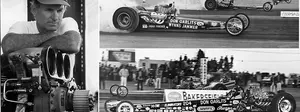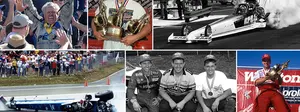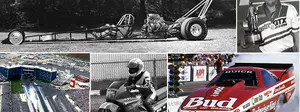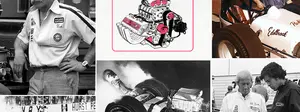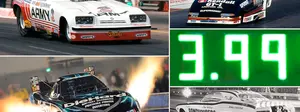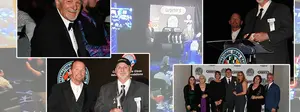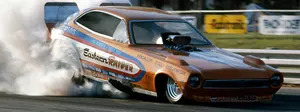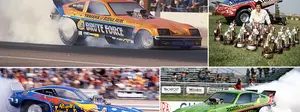

Magnificent Seven: A history of female racers in NHRA Pro Stock competition

Thirteen years before Pro Stock superstar Erica Enders turned a tire in the class and six years before current rookie hotshot Camrie Caruso was even born, Lucinda McFarlin made NHRA Pro Stock history as the first female racer in the class to win a round of racing.
Thirty years ago this season, at the 1992 NHRA Mid-South Nationals in Memphis, McFarlin etched her name into the record books when she defeated Don Beverley in the first round. It would be 13 years before fellow Texan Enders became the second female Pro Stock racer to turn on a win light when she defeated Rickie Smith at the 2005 Reading event in her rookie season.
In its 52-year, 902-race lifespan, only seven female drivers have raced in NHRA Pro Stock competition, and Enders, of course, stands head and shoulders above any female racer in the class — and certainly also above most of her male peers in the class — with four world championships, 34 national event wins, and 389 round-wins and counting in a sterling 17-year career. She was Pro Stock’s first female low qualifier, finalist, event winner, points leader, and world champion.
Despite all of those firsts, McFarlin’s stunning win in 1992 remains a slice of Pro Stock trivia and one that’s been frequently brought up this season after Caruso notched her first two round-wins.
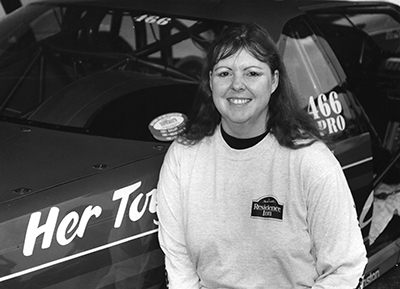
I met McFarlin back in the early 1990s, wrote a story about her for NHRA National Dragster, and she was gone by 1993, but she left behind her place in history. I often wondered what became of her, and with a little detective work, I was able to track her down earlier this week to get the story of her short but historic time in the class.
McFarlin, who hails from Victoria, Texas, got involved in racing through her husband, John, who took her to her first race in San Antonio in the 1980s.
“I told him it looked like fun, so he bought a car for me and brought it home,” she remembers. “It was just a bracket car that ran 14 seconds, but I really liked it and eventually moved up into Super Gas and Super Comp. I admit I wasn’t very good at that — don’t think I ever even won a round at a national event — but my goal was always to go to Pro Stock."

McFarlin’s Super Comp car — named, Her Toy, as was her Pro Stock car — was actually a door car, a Pontiac Firebird, and she used it to cut her Pro Stock teeth in the tough Texas Pro Stock Association in the late 1980s.
“My Super Comp car launched like a Pro Stocker, so I was comfortable in it; they had wanted me to run Comp first, but I wanted to be in Pro Stock,” she said.
She bought an Olds Cutlass — ironically, from Beverley — and turned to fellow Texans David Reher and Buddy Morrison for power. In 1992, she took delivery of a new Chevy Lumina from Don Ness and, with Pete Smith as her crew chief and husband John wrenching on the car, she qualified in her debut in the car in Houston that season in the No. 14 spot but lost in round one to Jerry Eckman. A few months later, she qualified No. 15 for the field in Memphis and drew No. 2 qualifier Beverley in the opening frame.
Beverley, who was running out of the Warren Johnson camp, was fresh off a victory at the tour’s previous event in Atlanta. Having outqualified her by six-hundredths in Memphis, he was the heavy favorite to beat her.
“There was a little bit of head games going on before the round,” she remembers. “Don's real nice, but I think he did not expect me to beat him. And he kind of told me that, and I just told him I was gonna give him the best run I could.”
Beverley’s car slowed from its 7.25 qualifying pace to a 7.44, and McFarlin drove by for the win with a 7.34.
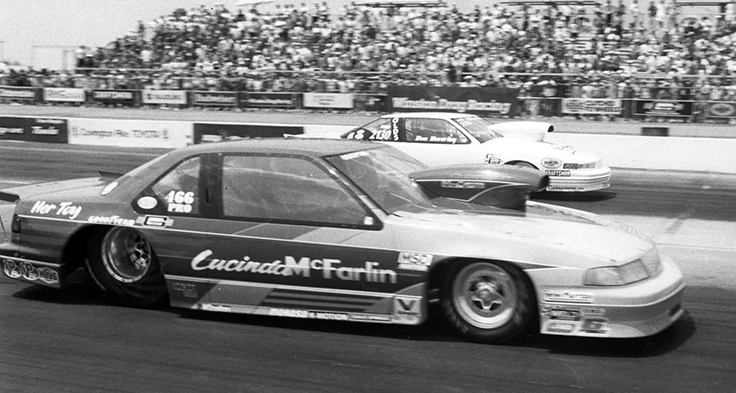
“When we got to the other end, [the TV cameras] went straight to him, so I thought I’d lost until I got my time slip,” she said, “but I guess at the time they thought the bigger story was him slowing down and losing rather than me winning.”
McFarlin shook and almost crossed the centerline against Harry Scribner in round two and, surprisingly, little was made of her historic feat, unlike the headlines that surround the achievements of today’s female racers, but it didn’t really bother her much.
“I just wanted to be a racer,” she said. “Being a woman racer, that didn't really matter to me. I was out there, just one of the guys. I never really thought about it until I started trying to talk to some of the guys. I especially remember when I went to congratulate Eckman after beating me in Houston, I couldn't understand why he had this face like he had lost, but it was because I came close to beating him. Later on, one of the guys told me that was because no one wanted to be the first one to be beaten by me.

“The fans, they were always very good to me. I always had pretty good fan support. That was something that took me a little while to get used to because all these guys wanted to come up, give me a hug, and take pictures and stuff. And I guess I never really considered myself that big of a deal. But even now, I go places and run into some that actually followed me on the circuit, so that feels really good.”
After she quit racing, she returned to her high school passion: flying.
“When I was younger, I didn't get to finish my license,” she recalls with a laugh. “All I needed was a cross-country trip to finish, but then I got married, had some kids, and my parents told me, ‘You’ve got responsibilities. Flying is dangerous. You need to quit flying,’ so I started racing, and I think they were afraid to tell me not to race. After racing, I started flying again and finished my license.”
Today, McFarlin works with the Civil Air Patrol out of Nacogdoches, Texas, trying to get kids into flying and doing search and rescue. She still follows the sport on a casual basis but not too closely for a simple reason: “If I followed too closely, I'd want to go racing again.”
As mentioned previously, Enders was Pro Stock’s first female low qualifier, finalist, event winner, points leader, and world champion, and while those firsts will be forever recorded in the history books, she also can’t lay claim to being the class’ first female competitor in the class.
Here’s a look at the other females who have competed in NHRA Pro Stock competition before and after Enders.
Shirley Shahan (1971)

Shirley Shahan, who had already made NHRA history as the first female event winner with her Stock victory at the 1966 Winternationals, made it into the trivia books again as one of NHRA’s first female Pro Stock contestants, competing at the 1971 Springnationals in Dallas.
Shahan was already an accomplished winner long before her big Winternationals victory — she won the March Meet in 1959 — but she and her husband, H.L., quickly proved her prowess in points meet competition, winning and setting records in the early 1960s in a Chevrolet. She landed a Dodge deal in 1965 and represented the company for the next four seasons, in everything from drag races to reliability runs. In 1969, American Motors wooed her to their camp, and she ran a Super Stock AMX with great success.
After a strong 1970 season in which she won class honors and set a slew of track records, she was ready for Pro Stock. AMC supplied her and H.L. with three cars — two Hornets and a Gremlin — and H.L. built up 360-cid engines for power. The Hornets were for national event competition and the Gremlin for match races, but neither performed up to expectations.
In her debut at the 1971 Springnationals in Dallas, suspension woes and a lack of spare parts kept her from the field. The Shahans made more history when both qualified for the 1971 U.S. Nationals. H.L. qualified No. 20 with a 9.892 but lost to their longtime friend and Tulare, Calif., neighbor Butch Leal in round one. Shirley qualified No. 31 with a 10.006 but lost in round one to “Fast Eddie” Schartman’s Comet.
Shahan also qualified No. 20 at the 1971 Supernationals at Ontario Motor Speedway but lost in round one to Ronnie Sox.
The Shahans asked AMC for a newer-model Hornet but were denied because AMC was spending a ton of money on its new NASCAR entry with Mark Donahue. Frustrated by that and the fact that their 360 engines couldn’t make the power they needed, they left racing after the 1971 season but left behind an enduring legacy.
Shay Nichols (1971-76)

Shay Nichols also was at that Dallas event in 1971 and also failed to qualify and ran on and off again for the next five years, but only for a total of six NHRA national events, and qualified at two: the 1972 World Finals in Amarillo and the 1976 Winternationals, but lost in the first round both times.
Nichols admittedly got into cars as a way to attract boys. Her first car was a World War II Jeep — replete with bullet holes — and self-taught herself a lot about cars. When she first heard about Shahan racing, she knew what she wanted to do.
“She was a goddess to me, and I hoped to be like her someday,” Nichols said in an interview in the June 1975 issue of Drag Racing U.S.A. magazine (ironically, the last issue of that fabled publication). “We were to meet only a few years later.”
Nichols eventually began racing with her husband, Phil, and in late 1963 and took delivery of what was purported to be the first Pontiac GTO to roll off the assembly line. When Phil left the Navy, they moved from San Francisco to Abilene, Texas, and ended up operating Steamboat Mountain Raceway, and Shay began racing in earnest in 1965, first in Powder Puff races and then onto quicker and after cars, including a 426-powered ’66 Dodge Charger. She moved into Stock eliminator and set several national records before moving up to Super Stock in 1969, driving a ZL1 Camaro for Dickie Harrell and in 1970 even appeared on the guess-what-I-do-for-a-living game show To Tell The Truth.
They converted their Super Stocker to Pro Stock trim for the 1971 season and raced for two years before switching to a Dodge Challenger in 1973. After a DNQ at the Gatornationals, she wrecked the car in Tyler, Texas, when a strong crosswind grabbed the car in the final round and sent her into a rollover crash in a ditch adjacent to the track. A new Duster was commissioned from Joe Smith Race Cars, and they competed through the 1976 season.
Judy Lilly (1982-84)

“Miss Mighty Mopar” had already built an amazing résumé in NHRA’s Sportsman ranks before a short, late-career move to Pro Stock that spanned just three races over two seasons.
Lilly began racing in Littleton, Colo., in 1961 with a D/Sports ’61 Corvette and won class honors at the 1965 Winternationals, which got the attention of Chrysler racing’s Bob Cahill and Dick Maxwell, who offered her a spot on the Mopar factory team with an SS/B Plymouth.
She switched to a Hemi Barracuda in 1968 and scored her first NHRA national event victory at the 1972 Winternationals, becoming just the third female national event winner behind Shahan and Judy Boertman (Stock at the 1971 Summernationals). She went on to record three more wins in Super Stock, her final victory coming in an SS/LA Plymouth Duster at the 1975 Fallnationals in Seattle, and three runner-ups, including at the 1975 U.S. Nationals. She was also named Car Craft Magazine Super Stock Driver of the Year in 1972, 1976, and 1977.
Lilly retired from driving at the end of the 1978 season and was idle for four years before returning to the cockpit in Pro Stock in Mike Musso’s entry, an ex-Dick Landy Omni. She finally qualified in her third and final event, at her homestate Mile-High Nationals in 1984, but lost in round one. The car was just not competitive and up to her winning standard, so the team parted company and Lilly went back into racing retirement.
Lilly was inducted into the International Drag Racing Hall of Fame in 1998 and the Colorado Motorsports Hall of Fame in 2005.
Erica Enders (2005-present)

Enders’ story is well known to today’s fans. A standout competitor in NHRA’s Jr. Drag Racing League and the star of the Disney movie Right on Track, she graduated to “big cars” and won her first national event in 2004, in Super Gas at her home track in Houston.
She moved up to Pro Stock in 2005 and failed to qualify in her debut at the Winternationals and DNQ’d at nine of her first 12 events in Victor Cagnazzi’s Cavalier. In her 19th career start, at the Keystone Nationals in Reading, she beat Rickie Smith in round one then reached the final round at the following event, the Route 66 Nationals in Chicago. Although she lost there to Jason Line, the die was clearly cast. She finished her rookie year with eight round-wins.
After parting with Cagnazzi after the 2007 season, she spent three tough years (2008-10) at the wheel of Jim Cunningham's Mustang, where she failed to qualify in 27 of 30 races and didn't win a round in the other three. She didn’t get a lot of success, but she got a lot of wheel time that no doubt helped turn her into the champion she became. It would be a fair guess that her years behind the wheel of less-powerful cars honed her the hair-trigger reflexes that have carried her to so many accomplishments.
She rejoined the Cagnazzi team from 2011 through 2013 and finished in the Top 10 all three seasons, with a best of fourth in 2012, then joined Elite Performance in 2014. She earned her first points lead in early 2014 en route to her first of four championships.
Grace Howell (2011-12)

Howell followed Enders into the seat of Cunningham’s Ford and also experienced middling success, qualifying for three races out of 15 without scoring a round-win. She did also earn a small part of Pro Stock trivia as part of the first Pro Stock race involving two female drivers when she and Enders made up half of the first-round quad at the Four-Wide Nationals in Charlotte in 2012. Enders finished second in the quad behind Mike Edwards to advance to round two, but Howell finished third, ending her day.
Howell — like Enders a second-generation driver who had cut her racing teeth in Jr. Dragsters — was the 10-year-old NHRA Jr. Drag Racing League national champion in 1996. She moved into the NHRA Sportsman ranks and was a well-regarded Super Stock racer and also competed in the All Motor class in NHRA’s Sport Compact Series. She moved to Australia in 2013 and raced in Pro Stock Down Under with partner Scott Porter.
Camrie Caruso (rookie season)
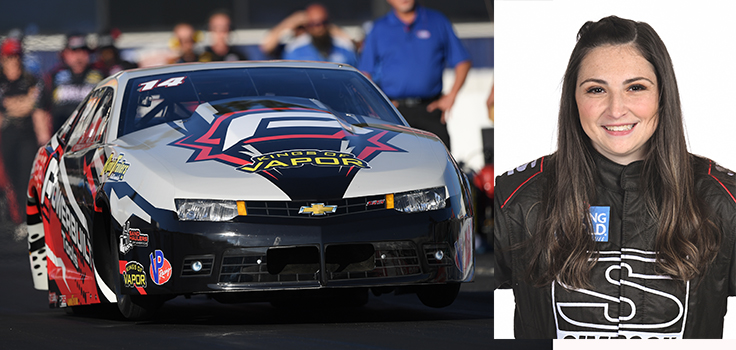
Caruso is a third-generation drag racer, following her father, Marc, a Pro Mod racer, and grandfather, Joe, who competed in Super Gas, Top Sportsman, and Pro Mod.
Before moving to Pro Stock this season, Caruso competed in Jr. Dragster, Super Comp, Top Alcohol Dragster, and Mountain Motor Pro Stock.
She qualified in her debut at the Winternationals, then won her first round-win a week later at the NHRA Arizona Nationals. When she notched her second win light of the season at the Amalie Motor Oil NHRA Gatornationals, she became the second-winningest female in NHRA Pro Stock competition, behind Enders.
Phil Burgess can be reached at pburgess@nhra.com
Hundreds of more articles like this can be found in the DRAGSTER INSIDER COLUMN ARCHIVE
Or try the Random Dragster Insider story generator



























